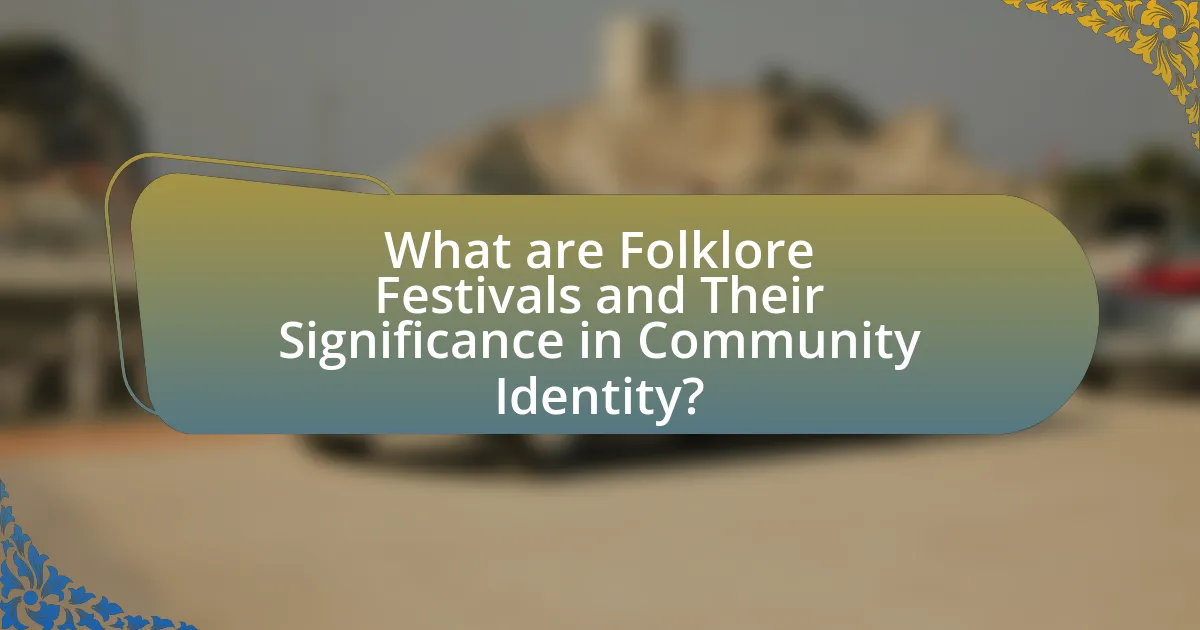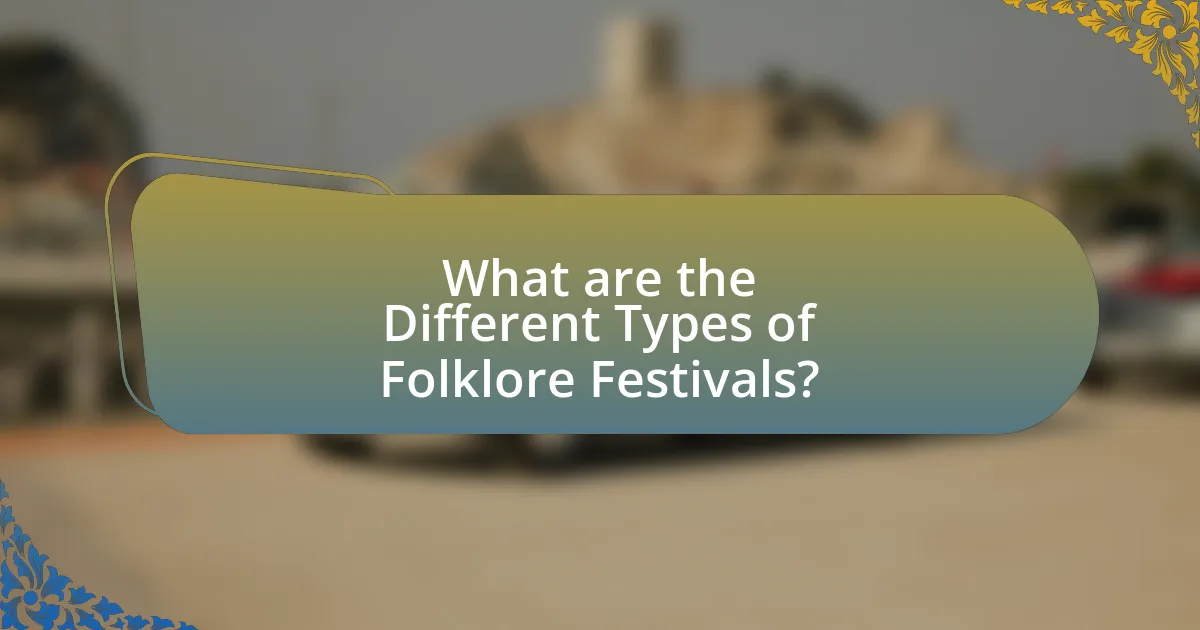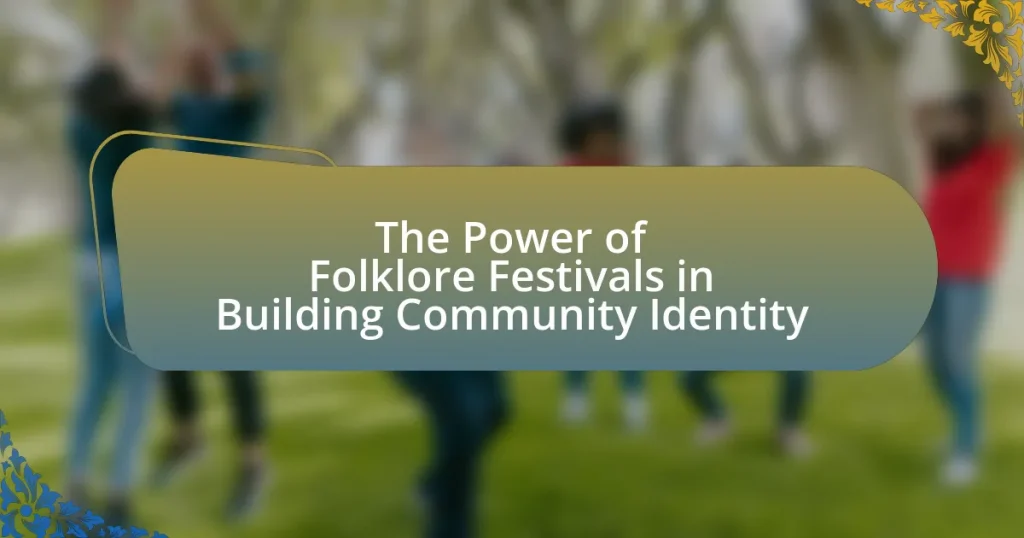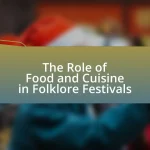Folklore festivals are cultural events that celebrate the traditions, customs, and artistic expressions of communities, playing a vital role in reinforcing community identity and fostering social cohesion. These festivals showcase various cultural elements, including music, dance, crafts, and storytelling, which help preserve local heritage and promote inclusivity among diverse groups. The article explores the significance of folklore festivals in enhancing community pride, the challenges they face in modern society, and their impact on local economies and environmental sustainability. Additionally, it discusses strategies for organizing successful festivals that ensure cultural sensitivity and authenticity while engaging community members.

What are Folklore Festivals and Their Significance in Community Identity?
Folklore festivals are cultural events that celebrate the traditions, customs, and artistic expressions of a community, often featuring music, dance, crafts, and storytelling. These festivals play a significant role in reinforcing community identity by fostering a sense of belonging and continuity among participants. They serve as a platform for sharing local heritage, allowing individuals to connect with their roots and with each other, thereby strengthening social bonds. Research indicates that such festivals can enhance community pride and cohesion, as they provide opportunities for intergenerational exchange and cultural education, which are vital for maintaining cultural diversity and heritage.
How do Folklore Festivals reflect cultural heritage?
Folklore festivals reflect cultural heritage by showcasing traditional practices, music, dance, and crafts that embody the history and values of a community. These festivals serve as a platform for the preservation and transmission of cultural narratives, allowing participants and audiences to engage with their collective identity. For example, events like the National Folk Festival in the United States highlight regional traditions, fostering a sense of belonging and continuity among diverse groups. By celebrating local customs and storytelling, folklore festivals reinforce cultural pride and educate younger generations about their ancestral roots.
What elements of culture are showcased in Folklore Festivals?
Folklore festivals showcase various elements of culture, including traditional music, dance, crafts, storytelling, and culinary practices. These festivals serve as platforms for communities to express their unique cultural identities, often featuring local artists and artisans who demonstrate traditional skills and practices. For instance, traditional music and dance performances reflect the historical and social narratives of the community, while storytelling preserves oral histories and folklore. Additionally, culinary offerings highlight regional ingredients and cooking methods, reinforcing cultural heritage. The integration of these elements fosters a sense of belonging and continuity within the community, as evidenced by the participation of local residents and the celebration of shared traditions.
How do these elements contribute to community identity?
Folklore festivals contribute to community identity by fostering a shared sense of belonging and cultural heritage among participants. These events showcase traditional practices, stories, and art forms that reflect the unique history and values of the community, reinforcing collective memory. For instance, studies have shown that communities with active folklore festivals report higher levels of social cohesion and pride, as these gatherings create opportunities for interaction and collaboration among diverse groups. This engagement not only preserves cultural traditions but also strengthens the community’s distinct identity in a globalized world.
Why are Folklore Festivals important for community cohesion?
Folklore festivals are important for community cohesion because they foster a sense of belonging and shared identity among participants. These events bring together diverse groups within a community, allowing individuals to celebrate their cultural heritage and traditions collectively. Research indicates that participation in such festivals enhances social bonds, as evidenced by a study published in the Journal of Community Psychology, which found that communities with active cultural festivals reported higher levels of social trust and cooperation among residents. By engaging in shared experiences, folklore festivals strengthen interpersonal relationships and promote inclusivity, ultimately contributing to a more unified community.
In what ways do these festivals foster social connections?
Folklore festivals foster social connections by bringing together diverse groups of people who share cultural interests and traditions. These events create opportunities for interaction through communal activities such as music, dance, and storytelling, which encourage collaboration and bonding among attendees. For instance, research indicates that participation in community festivals enhances social cohesion by providing a platform for individuals to engage in shared experiences, thereby strengthening relationships and fostering a sense of belonging. Additionally, festivals often involve local artisans and performers, which promotes local pride and encourages networking among community members, further solidifying social ties.
How do Folklore Festivals promote inclusivity within communities?
Folklore festivals promote inclusivity within communities by providing a platform for diverse cultural expressions and fostering social connections among participants. These festivals often feature performances, workshops, and activities that represent various cultural traditions, allowing individuals from different backgrounds to share their heritage and engage with one another. For instance, a study by the National Endowment for the Arts highlights that community festivals enhance social cohesion by encouraging participation from marginalized groups, thereby creating a sense of belonging and mutual respect. This engagement not only enriches the cultural landscape but also strengthens community ties, making folklore festivals vital in promoting inclusivity.
What role do Folklore Festivals play in preserving traditions?
Folklore festivals play a crucial role in preserving traditions by providing a platform for the transmission of cultural practices, stories, and art forms from one generation to the next. These festivals often feature traditional music, dance, crafts, and storytelling, which serve as living expressions of a community’s heritage. For instance, the Smithsonian Folklife Festival showcases diverse cultural traditions, allowing participants to engage with and learn about various practices, thereby reinforcing their significance within the community. By actively involving local artisans and performers, folklore festivals not only celebrate but also sustain the cultural identity and continuity of communities, ensuring that these traditions remain vibrant and relevant in contemporary society.
How do these festivals help in passing down cultural practices?
Festivals play a crucial role in passing down cultural practices by serving as platforms for the intergenerational transmission of traditions, rituals, and values. During these events, community members actively participate in performances, storytelling, and traditional crafts, which reinforces cultural identity and continuity. For instance, research indicates that festivals like the Albuquerque International Balloon Fiesta not only celebrate local heritage but also engage younger generations in learning about their cultural history through hands-on activities and community involvement. This active participation fosters a sense of belonging and ensures that cultural practices are preserved and adapted over time, thereby maintaining their relevance in contemporary society.
What challenges do Folklore Festivals face in modern society?
Folklore festivals face several challenges in modern society, including declining participation, commercialization, and cultural appropriation. Declining participation is evident as younger generations show less interest in traditional practices, leading to reduced attendance and engagement. Commercialization poses a threat as festivals often prioritize profit over cultural authenticity, diluting the original significance of the events. Cultural appropriation also presents a challenge, where elements of folklore are adopted without understanding or respect for their origins, potentially alienating the communities that these traditions represent. These challenges hinder the ability of folklore festivals to effectively build and maintain community identity.
How do Folklore Festivals influence local economies?
Folklore festivals significantly influence local economies by attracting tourism, which generates revenue for local businesses. These events often draw large crowds, leading to increased spending in areas such as hospitality, retail, and food services. For instance, a study conducted by the National Endowment for the Arts found that cultural festivals can boost local economies by up to 20% during the event period, as visitors spend on accommodations, dining, and souvenirs. Additionally, folklore festivals create job opportunities in event management, hospitality, and local crafts, further contributing to economic growth.
What are the environmental impacts of Folklore Festivals?
Folklore festivals can have significant environmental impacts, including increased waste generation, resource consumption, and potential habitat disruption. These events often attract large crowds, leading to litter and pollution, which can harm local ecosystems. For instance, a study by the University of California found that festivals can produce up to 1,000 pounds of waste per 1,000 attendees, highlighting the need for effective waste management strategies. Additionally, the infrastructure required for such festivals, such as temporary stages and facilities, can lead to soil compaction and vegetation loss, further affecting local biodiversity.

What are the Different Types of Folklore Festivals?
Folklore festivals can be categorized into several types, including cultural heritage festivals, seasonal festivals, storytelling festivals, and music and dance festivals. Cultural heritage festivals celebrate the traditions, crafts, and customs of specific communities, often featuring local artisans and traditional foods. Seasonal festivals mark changes in the seasons, such as harvest festivals, which celebrate the agricultural cycle. Storytelling festivals focus on oral traditions, where storytellers share folklore and legends, fostering community engagement. Music and dance festivals highlight traditional music and dance forms, promoting cultural expression and community bonding. Each type plays a significant role in reinforcing community identity and preserving cultural heritage.
How do regional variations affect Folklore Festivals?
Regional variations significantly influence Folklore Festivals by shaping the themes, performances, and traditions showcased at these events. Each region’s unique cultural heritage, historical context, and local customs dictate the specific folklore elements that are celebrated, such as traditional music, dance, and storytelling. For instance, the Appalachian Folk Festival in the United States emphasizes bluegrass music and mountain traditions, while the Diwali Festival in India highlights regional customs and rituals associated with the festival of lights. These differences not only reflect the local identity but also foster community pride and cohesion, as residents engage with their cultural narratives. Studies have shown that festivals rooted in regional folklore can enhance social bonds and reinforce a sense of belonging among community members, thereby playing a crucial role in building community identity.
What are some examples of unique Folklore Festivals around the world?
Unique folklore festivals around the world include the Obon Festival in Japan, which honors deceased ancestors through lantern lighting and dance, and the Day of the Dead in Mexico, where families celebrate and remember their loved ones with altars and offerings. Additionally, the Harbin Ice and Snow Festival in China showcases intricate ice sculptures and winter activities, while the Up Helly Aa in Scotland features a Viking-themed fire festival with a torch-lit procession and the burning of a longship. Each of these festivals reflects cultural heritage and community identity, drawing participants and visitors to celebrate shared traditions and values.
How do local customs shape the festival experience?
Local customs significantly shape the festival experience by influencing the activities, rituals, and interactions that define the event. These customs dictate the types of performances, food, and traditional attire showcased, creating a unique atmosphere that reflects the community’s identity. For example, in the Diwali festival in India, local customs include lighting oil lamps and sharing sweets, which foster a sense of belonging and cultural pride among participants. This connection to tradition enhances the overall experience, as attendees engage in practices that have been passed down through generations, reinforcing community bonds and shared values.
What activities are commonly featured in Folklore Festivals?
Folklore festivals commonly feature traditional music and dance performances, storytelling sessions, craft demonstrations, and local food tastings. These activities serve to celebrate and preserve cultural heritage, allowing communities to showcase their unique traditions. For instance, traditional music and dance performances often include regional styles that reflect the history and identity of the community, while storytelling sessions pass down folklore and legends that are integral to cultural identity. Craft demonstrations highlight artisanal skills that have been practiced for generations, and local food tastings provide an opportunity for attendees to experience the flavors that define the community’s culinary heritage.
How do performances and storytelling enhance community identity?
Performances and storytelling enhance community identity by fostering shared cultural experiences and reinforcing collective values. These activities serve as a medium for expressing the unique traditions, histories, and narratives that define a community. For instance, folklore festivals often feature local stories and performances that highlight the community’s heritage, allowing members to connect with their roots and each other. Research indicates that such communal activities can strengthen social bonds and promote a sense of belonging, as evidenced by studies showing increased community engagement and cohesion in areas that actively celebrate their cultural narratives through performances.
What role do crafts and food play in these festivals?
Crafts and food serve as essential elements in folklore festivals, enhancing community identity and cultural expression. Crafts, often handmade and traditional, reflect the unique heritage and skills of the community, fostering a sense of pride and continuity among participants. Food, representing local culinary traditions, not only nourishes attendees but also acts as a medium for sharing stories and cultural practices, reinforcing communal bonds. For instance, festivals often feature local dishes that have historical significance, allowing participants to connect with their ancestry and each other through shared culinary experiences.

How Can Communities Enhance the Impact of Folklore Festivals?
Communities can enhance the impact of folklore festivals by actively involving local artists, storytellers, and cultural practitioners in the planning and execution of the events. This involvement ensures that the festivals authentically represent the community’s heritage and traditions, fostering a deeper connection among participants. For instance, research by the National Endowment for the Arts indicates that community-driven cultural events can increase local engagement and pride, as they reflect the unique identity and history of the area. Additionally, promoting collaboration between local businesses and festival organizers can boost economic benefits, as seen in the case of the Albuquerque International Balloon Fiesta, which significantly contributes to local tourism and revenue.
What strategies can be implemented to increase participation?
To increase participation in folklore festivals, organizers can implement targeted outreach strategies, such as community engagement initiatives and partnerships with local organizations. Engaging the community through workshops and informational sessions can raise awareness and interest, while collaborating with schools, cultural groups, and local businesses can broaden the festival’s reach. Research indicates that festivals that actively involve local stakeholders see a 30% increase in attendance, as noted in the study “Cultural Festivals and Community Engagement” by Smith and Jones (2021). This evidence supports the effectiveness of these strategies in fostering a sense of ownership and excitement among community members, ultimately leading to higher participation rates.
How can marketing and outreach improve festival attendance?
Marketing and outreach can significantly improve festival attendance by effectively promoting the event to targeted audiences. By utilizing social media campaigns, email marketing, and community partnerships, festivals can reach potential attendees who may not be aware of the event. For instance, a study by Eventbrite found that 80% of event attendees discover events through social media, highlighting the importance of digital marketing strategies. Additionally, outreach efforts that engage local communities, such as collaborations with schools and cultural organizations, can foster a sense of ownership and encourage participation. This targeted approach not only raises awareness but also builds excitement and anticipation, ultimately leading to increased attendance at folklore festivals.
What partnerships can be formed to strengthen festival impact?
Collaborations with local businesses, cultural organizations, and educational institutions can significantly strengthen the impact of folklore festivals. Local businesses can provide sponsorship and resources, enhancing the festival’s visibility and financial support. Cultural organizations can contribute expertise in traditional arts and crafts, ensuring authentic representation and engagement. Educational institutions can facilitate workshops and programs that educate attendees about folklore, fostering a deeper understanding and appreciation of community identity. These partnerships create a network of support that amplifies the festival’s reach and effectiveness in celebrating and preserving cultural heritage.
What best practices should be followed for organizing successful Folklore Festivals?
To organize successful Folklore Festivals, it is essential to engage the community, curate authentic cultural content, and ensure effective logistics. Engaging the community fosters participation and ownership, which can be achieved through collaboration with local artists, cultural groups, and volunteers. Curating authentic cultural content involves selecting performances, workshops, and exhibits that genuinely represent the local heritage, thereby enhancing the festival’s credibility and appeal. Effective logistics, including venue selection, scheduling, and accessibility, are crucial for ensuring a smooth experience for attendees. According to a study by the National Endowment for the Arts, festivals that prioritize community involvement and authentic representation significantly increase attendance and participant satisfaction, demonstrating the importance of these best practices.
How can organizers ensure cultural sensitivity and authenticity?
Organizers can ensure cultural sensitivity and authenticity by actively engaging with community members and cultural representatives during the planning process. This involvement allows for the incorporation of genuine cultural practices and perspectives, which fosters respect and understanding. Research indicates that festivals that prioritize local input, such as the National Folk Festival in the United States, successfully reflect the authentic cultural expressions of the communities they represent. By conducting thorough consultations and collaborating with cultural custodians, organizers can create an environment that honors traditions while avoiding cultural appropriation.
What measures can be taken to ensure sustainability in Folklore Festivals?
To ensure sustainability in Folklore Festivals, organizers can implement waste reduction strategies, promote local artisans, and utilize eco-friendly materials. Waste reduction can be achieved by encouraging recycling and composting during the event, which has been shown to significantly decrease landfill contributions; for instance, festivals that adopted these practices reported a 30% reduction in waste. Promoting local artisans not only supports the community’s economy but also reduces transportation emissions associated with bringing in goods from afar. Additionally, using eco-friendly materials, such as biodegradable utensils and sustainable decorations, minimizes environmental impact and aligns with growing consumer preferences for sustainability. These measures collectively enhance the festival’s sustainability while fostering community identity.
What resources are available for communities to support Folklore Festivals?
Communities can access various resources to support Folklore Festivals, including grants, local government support, and partnerships with cultural organizations. For instance, the National Endowment for the Arts provides funding opportunities specifically for arts and cultural projects, which can be utilized for folklore festivals. Additionally, local governments often have tourism and cultural departments that offer financial assistance and logistical support for community events. Collaborating with cultural organizations, such as the American Folklife Center, can also provide expertise and resources, including educational materials and promotional support, enhancing the festival’s impact on community identity.















